BMP3004 World of Work: Employee Motivation Factors & Job Impact
VerifiedAdded on 2023/06/12
|8
|2057
|243
Report
AI Summary
This report explores the crucial role of employee motivation in modern business, defining motivation as a process of guiding and maintaining a productive work environment. It delves into intrinsic and extrinsic motivation, highlighting Maslow's Hierarchy of Needs as a foundational theory. The report identifies key factors that motivate employees, such as recognition, positive work environments, leadership, and job security. It also examines the positive impacts of skill development and work-life balance, alongside negative factors like workplace conflicts and lack of innovation. The conclusion emphasizes the importance of understanding and addressing these factors to enhance employee performance and organizational success. This assignment is available on Desklib, a platform offering study tools and resources for students.
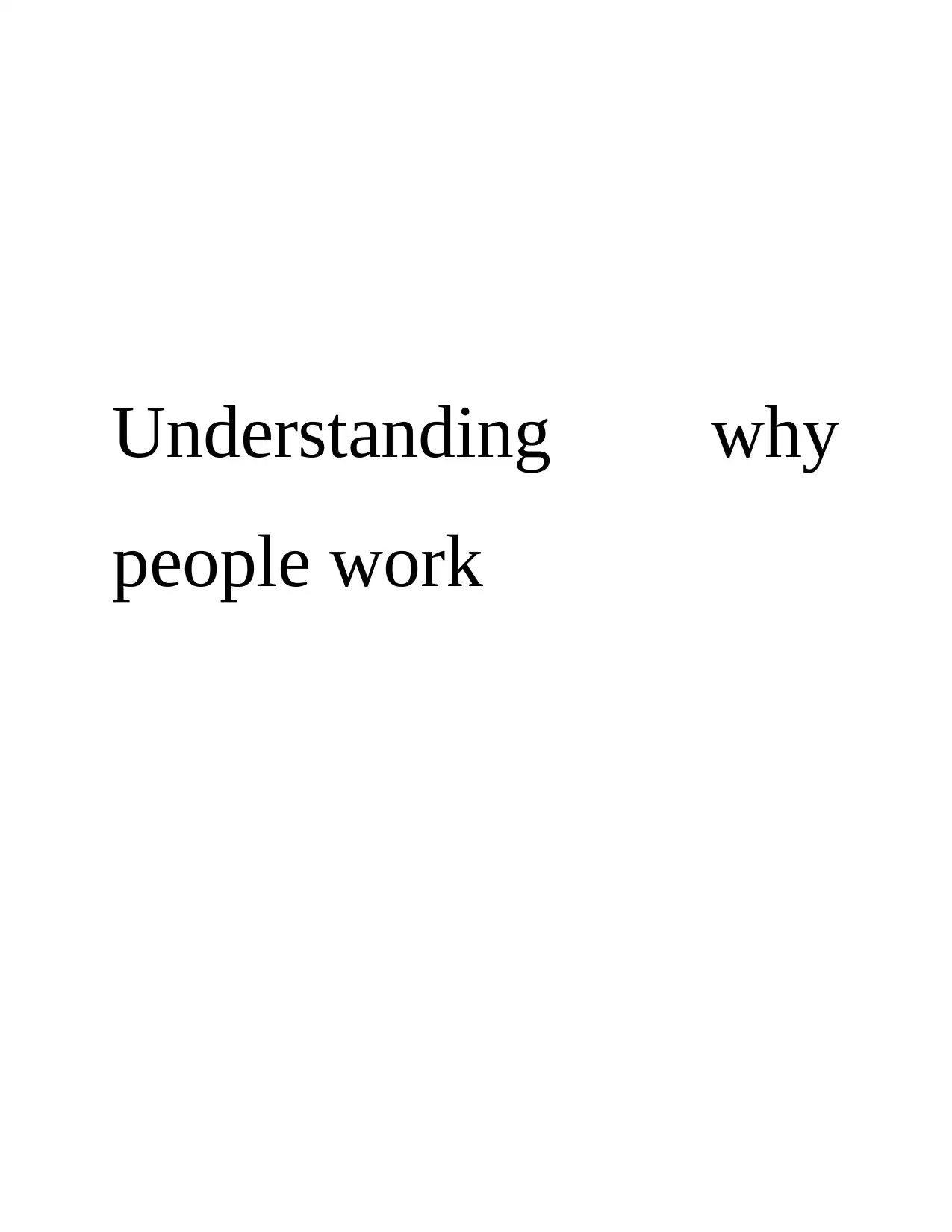
Understanding why
people work
people work
Paraphrase This Document
Need a fresh take? Get an instant paraphrase of this document with our AI Paraphraser
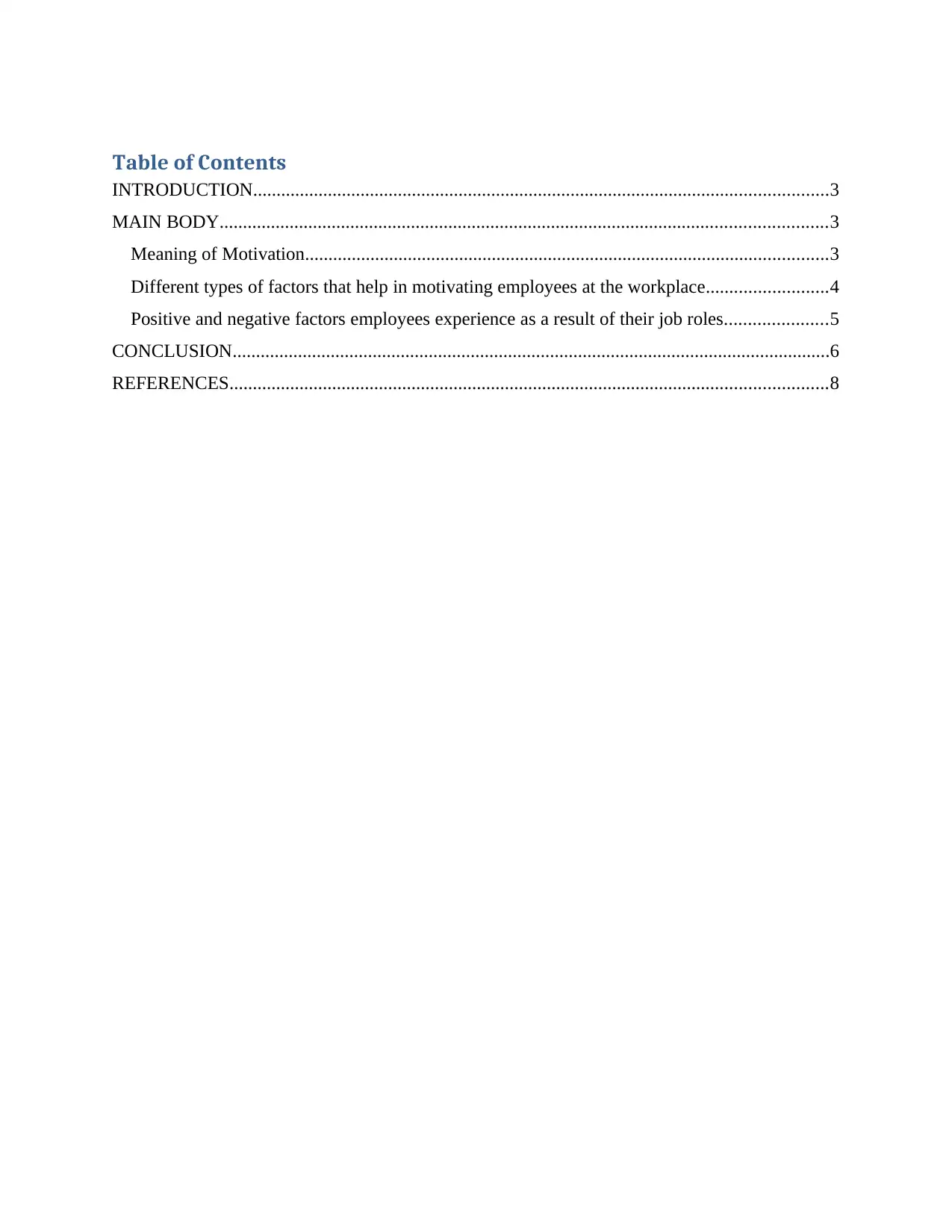
Table of Contents
INTRODUCTION...........................................................................................................................3
MAIN BODY..................................................................................................................................3
Meaning of Motivation................................................................................................................3
Different types of factors that help in motivating employees at the workplace..........................4
Positive and negative factors employees experience as a result of their job roles......................5
CONCLUSION................................................................................................................................6
REFERENCES................................................................................................................................8
INTRODUCTION...........................................................................................................................3
MAIN BODY..................................................................................................................................3
Meaning of Motivation................................................................................................................3
Different types of factors that help in motivating employees at the workplace..........................4
Positive and negative factors employees experience as a result of their job roles......................5
CONCLUSION................................................................................................................................6
REFERENCES................................................................................................................................8
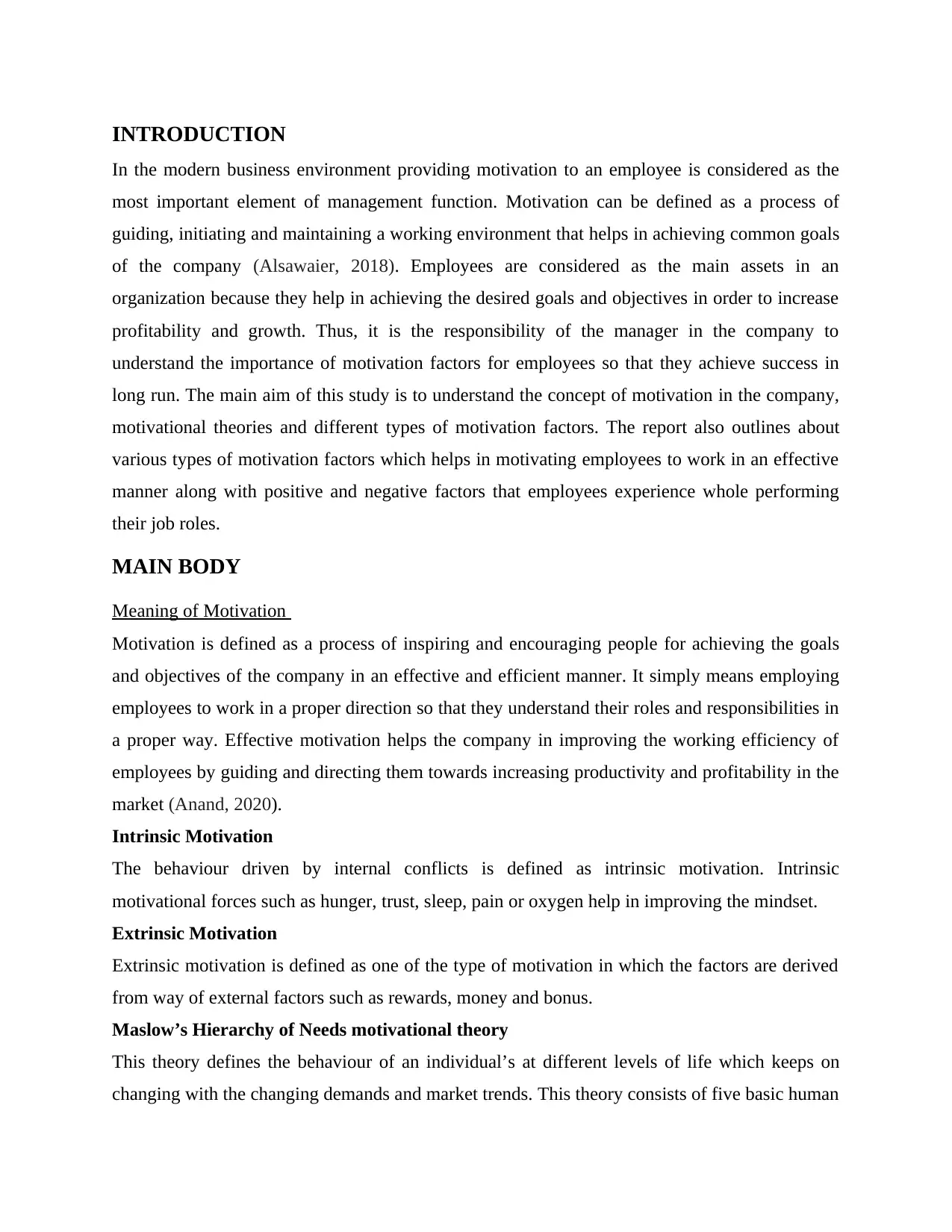
INTRODUCTION
In the modern business environment providing motivation to an employee is considered as the
most important element of management function. Motivation can be defined as a process of
guiding, initiating and maintaining a working environment that helps in achieving common goals
of the company (Alsawaier, 2018). Employees are considered as the main assets in an
organization because they help in achieving the desired goals and objectives in order to increase
profitability and growth. Thus, it is the responsibility of the manager in the company to
understand the importance of motivation factors for employees so that they achieve success in
long run. The main aim of this study is to understand the concept of motivation in the company,
motivational theories and different types of motivation factors. The report also outlines about
various types of motivation factors which helps in motivating employees to work in an effective
manner along with positive and negative factors that employees experience whole performing
their job roles.
MAIN BODY
Meaning of Motivation
Motivation is defined as a process of inspiring and encouraging people for achieving the goals
and objectives of the company in an effective and efficient manner. It simply means employing
employees to work in a proper direction so that they understand their roles and responsibilities in
a proper way. Effective motivation helps the company in improving the working efficiency of
employees by guiding and directing them towards increasing productivity and profitability in the
market (Anand, 2020).
Intrinsic Motivation
The behaviour driven by internal conflicts is defined as intrinsic motivation. Intrinsic
motivational forces such as hunger, trust, sleep, pain or oxygen help in improving the mindset.
Extrinsic Motivation
Extrinsic motivation is defined as one of the type of motivation in which the factors are derived
from way of external factors such as rewards, money and bonus.
Maslow’s Hierarchy of Needs motivational theory
This theory defines the behaviour of an individual’s at different levels of life which keeps on
changing with the changing demands and market trends. This theory consists of five basic human
In the modern business environment providing motivation to an employee is considered as the
most important element of management function. Motivation can be defined as a process of
guiding, initiating and maintaining a working environment that helps in achieving common goals
of the company (Alsawaier, 2018). Employees are considered as the main assets in an
organization because they help in achieving the desired goals and objectives in order to increase
profitability and growth. Thus, it is the responsibility of the manager in the company to
understand the importance of motivation factors for employees so that they achieve success in
long run. The main aim of this study is to understand the concept of motivation in the company,
motivational theories and different types of motivation factors. The report also outlines about
various types of motivation factors which helps in motivating employees to work in an effective
manner along with positive and negative factors that employees experience whole performing
their job roles.
MAIN BODY
Meaning of Motivation
Motivation is defined as a process of inspiring and encouraging people for achieving the goals
and objectives of the company in an effective and efficient manner. It simply means employing
employees to work in a proper direction so that they understand their roles and responsibilities in
a proper way. Effective motivation helps the company in improving the working efficiency of
employees by guiding and directing them towards increasing productivity and profitability in the
market (Anand, 2020).
Intrinsic Motivation
The behaviour driven by internal conflicts is defined as intrinsic motivation. Intrinsic
motivational forces such as hunger, trust, sleep, pain or oxygen help in improving the mindset.
Extrinsic Motivation
Extrinsic motivation is defined as one of the type of motivation in which the factors are derived
from way of external factors such as rewards, money and bonus.
Maslow’s Hierarchy of Needs motivational theory
This theory defines the behaviour of an individual’s at different levels of life which keeps on
changing with the changing demands and market trends. This theory consists of five basic human
⊘ This is a preview!⊘
Do you want full access?
Subscribe today to unlock all pages.

Trusted by 1+ million students worldwide
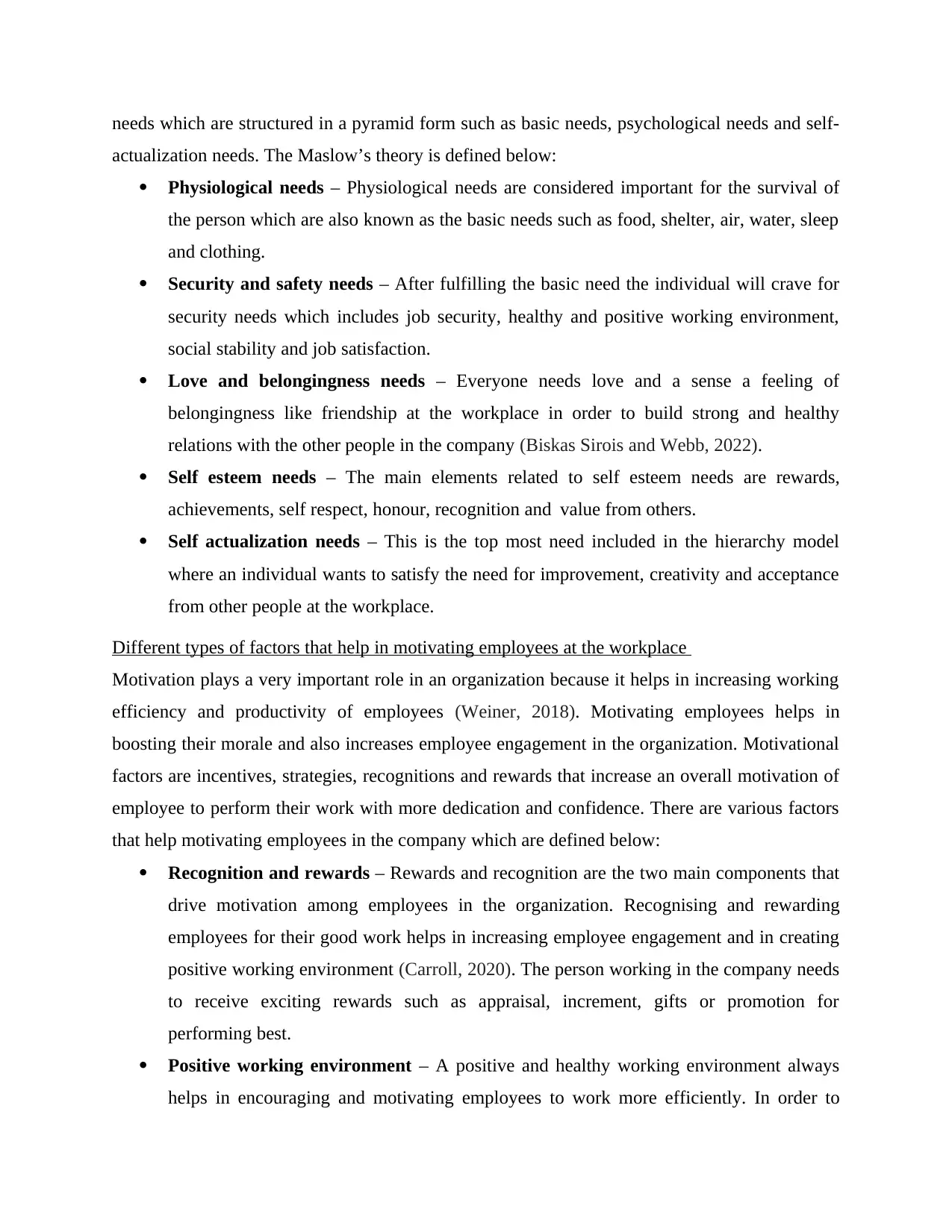
needs which are structured in a pyramid form such as basic needs, psychological needs and self-
actualization needs. The Maslow’s theory is defined below:
Physiological needs – Physiological needs are considered important for the survival of
the person which are also known as the basic needs such as food, shelter, air, water, sleep
and clothing.
Security and safety needs – After fulfilling the basic need the individual will crave for
security needs which includes job security, healthy and positive working environment,
social stability and job satisfaction.
Love and belongingness needs – Everyone needs love and a sense a feeling of
belongingness like friendship at the workplace in order to build strong and healthy
relations with the other people in the company (Biskas Sirois and Webb, 2022).
Self esteem needs – The main elements related to self esteem needs are rewards,
achievements, self respect, honour, recognition and value from others.
Self actualization needs – This is the top most need included in the hierarchy model
where an individual wants to satisfy the need for improvement, creativity and acceptance
from other people at the workplace.
Different types of factors that help in motivating employees at the workplace
Motivation plays a very important role in an organization because it helps in increasing working
efficiency and productivity of employees (Weiner, 2018). Motivating employees helps in
boosting their morale and also increases employee engagement in the organization. Motivational
factors are incentives, strategies, recognitions and rewards that increase an overall motivation of
employee to perform their work with more dedication and confidence. There are various factors
that help motivating employees in the company which are defined below:
Recognition and rewards – Rewards and recognition are the two main components that
drive motivation among employees in the organization. Recognising and rewarding
employees for their good work helps in increasing employee engagement and in creating
positive working environment (Carroll, 2020). The person working in the company needs
to receive exciting rewards such as appraisal, increment, gifts or promotion for
performing best.
Positive working environment – A positive and healthy working environment always
helps in encouraging and motivating employees to work more efficiently. In order to
actualization needs. The Maslow’s theory is defined below:
Physiological needs – Physiological needs are considered important for the survival of
the person which are also known as the basic needs such as food, shelter, air, water, sleep
and clothing.
Security and safety needs – After fulfilling the basic need the individual will crave for
security needs which includes job security, healthy and positive working environment,
social stability and job satisfaction.
Love and belongingness needs – Everyone needs love and a sense a feeling of
belongingness like friendship at the workplace in order to build strong and healthy
relations with the other people in the company (Biskas Sirois and Webb, 2022).
Self esteem needs – The main elements related to self esteem needs are rewards,
achievements, self respect, honour, recognition and value from others.
Self actualization needs – This is the top most need included in the hierarchy model
where an individual wants to satisfy the need for improvement, creativity and acceptance
from other people at the workplace.
Different types of factors that help in motivating employees at the workplace
Motivation plays a very important role in an organization because it helps in increasing working
efficiency and productivity of employees (Weiner, 2018). Motivating employees helps in
boosting their morale and also increases employee engagement in the organization. Motivational
factors are incentives, strategies, recognitions and rewards that increase an overall motivation of
employee to perform their work with more dedication and confidence. There are various factors
that help motivating employees in the company which are defined below:
Recognition and rewards – Rewards and recognition are the two main components that
drive motivation among employees in the organization. Recognising and rewarding
employees for their good work helps in increasing employee engagement and in creating
positive working environment (Carroll, 2020). The person working in the company needs
to receive exciting rewards such as appraisal, increment, gifts or promotion for
performing best.
Positive working environment – A positive and healthy working environment always
helps in encouraging and motivating employees to work more efficiently. In order to
Paraphrase This Document
Need a fresh take? Get an instant paraphrase of this document with our AI Paraphraser
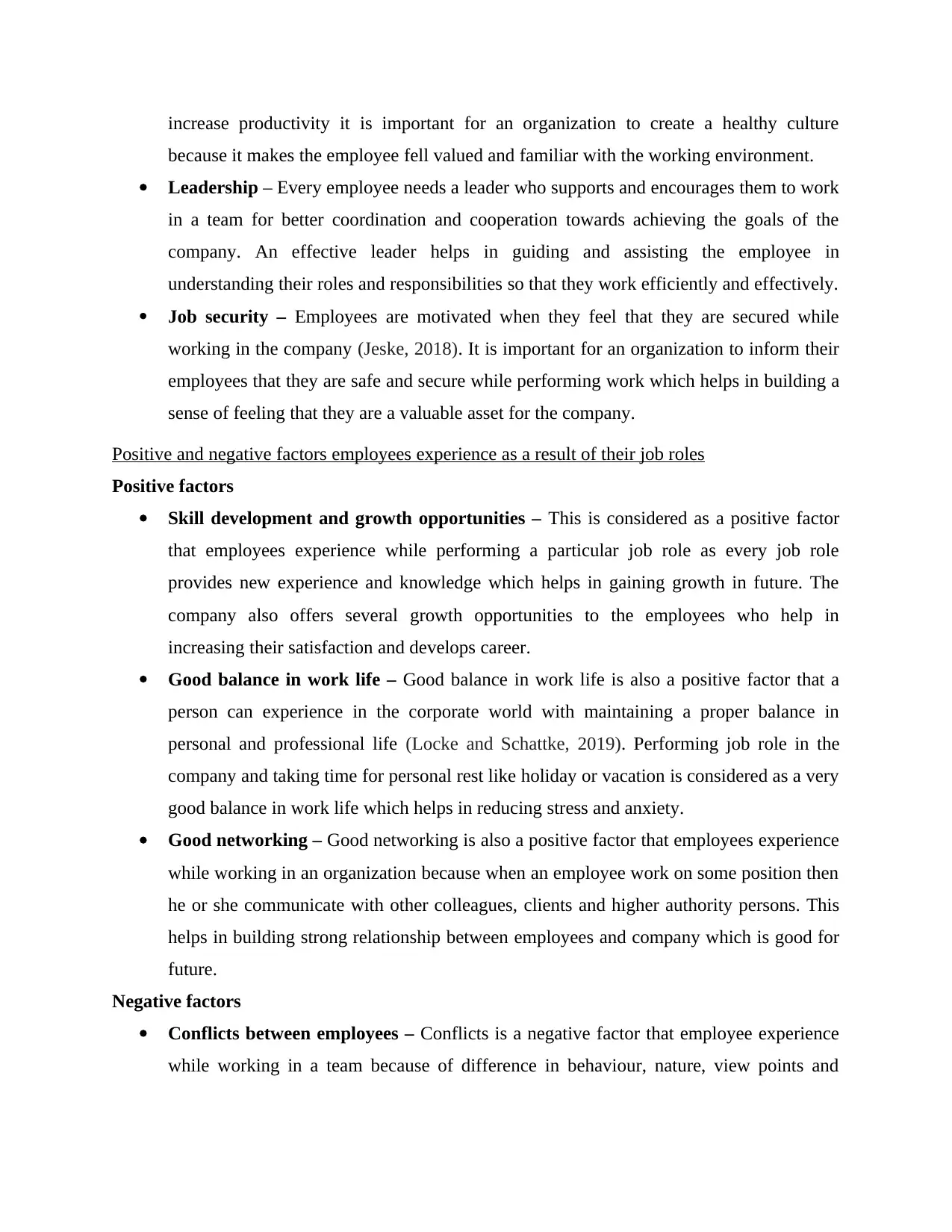
increase productivity it is important for an organization to create a healthy culture
because it makes the employee fell valued and familiar with the working environment.
Leadership – Every employee needs a leader who supports and encourages them to work
in a team for better coordination and cooperation towards achieving the goals of the
company. An effective leader helps in guiding and assisting the employee in
understanding their roles and responsibilities so that they work efficiently and effectively.
Job security – Employees are motivated when they feel that they are secured while
working in the company (Jeske, 2018). It is important for an organization to inform their
employees that they are safe and secure while performing work which helps in building a
sense of feeling that they are a valuable asset for the company.
Positive and negative factors employees experience as a result of their job roles
Positive factors
Skill development and growth opportunities – This is considered as a positive factor
that employees experience while performing a particular job role as every job role
provides new experience and knowledge which helps in gaining growth in future. The
company also offers several growth opportunities to the employees who help in
increasing their satisfaction and develops career.
Good balance in work life – Good balance in work life is also a positive factor that a
person can experience in the corporate world with maintaining a proper balance in
personal and professional life (Locke and Schattke, 2019). Performing job role in the
company and taking time for personal rest like holiday or vacation is considered as a very
good balance in work life which helps in reducing stress and anxiety.
Good networking – Good networking is also a positive factor that employees experience
while working in an organization because when an employee work on some position then
he or she communicate with other colleagues, clients and higher authority persons. This
helps in building strong relationship between employees and company which is good for
future.
Negative factors
Conflicts between employees – Conflicts is a negative factor that employee experience
while working in a team because of difference in behaviour, nature, view points and
because it makes the employee fell valued and familiar with the working environment.
Leadership – Every employee needs a leader who supports and encourages them to work
in a team for better coordination and cooperation towards achieving the goals of the
company. An effective leader helps in guiding and assisting the employee in
understanding their roles and responsibilities so that they work efficiently and effectively.
Job security – Employees are motivated when they feel that they are secured while
working in the company (Jeske, 2018). It is important for an organization to inform their
employees that they are safe and secure while performing work which helps in building a
sense of feeling that they are a valuable asset for the company.
Positive and negative factors employees experience as a result of their job roles
Positive factors
Skill development and growth opportunities – This is considered as a positive factor
that employees experience while performing a particular job role as every job role
provides new experience and knowledge which helps in gaining growth in future. The
company also offers several growth opportunities to the employees who help in
increasing their satisfaction and develops career.
Good balance in work life – Good balance in work life is also a positive factor that a
person can experience in the corporate world with maintaining a proper balance in
personal and professional life (Locke and Schattke, 2019). Performing job role in the
company and taking time for personal rest like holiday or vacation is considered as a very
good balance in work life which helps in reducing stress and anxiety.
Good networking – Good networking is also a positive factor that employees experience
while working in an organization because when an employee work on some position then
he or she communicate with other colleagues, clients and higher authority persons. This
helps in building strong relationship between employees and company which is good for
future.
Negative factors
Conflicts between employees – Conflicts is a negative factor that employee experience
while working in a team because of difference in behaviour, nature, view points and
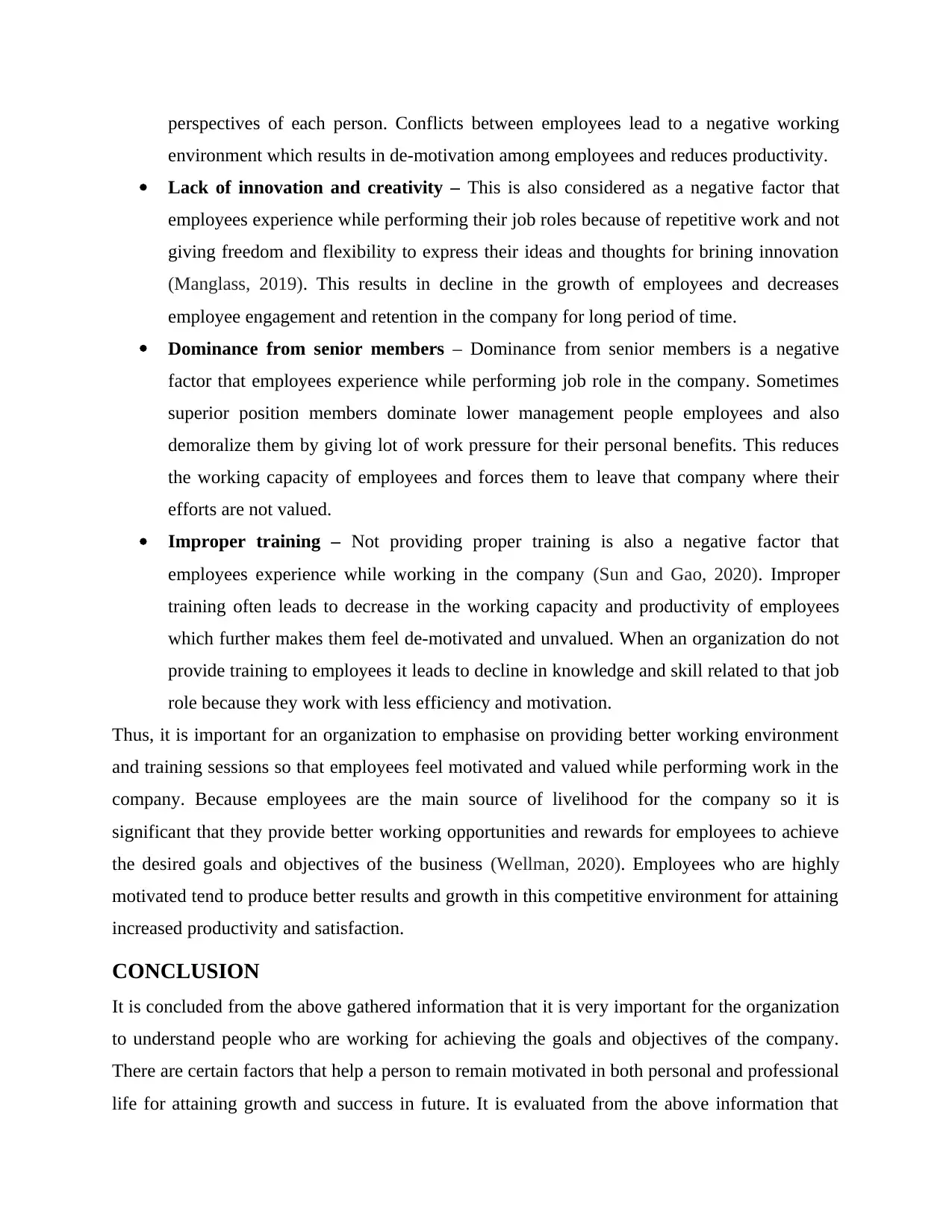
perspectives of each person. Conflicts between employees lead to a negative working
environment which results in de-motivation among employees and reduces productivity.
Lack of innovation and creativity – This is also considered as a negative factor that
employees experience while performing their job roles because of repetitive work and not
giving freedom and flexibility to express their ideas and thoughts for brining innovation
(Manglass, 2019). This results in decline in the growth of employees and decreases
employee engagement and retention in the company for long period of time.
Dominance from senior members – Dominance from senior members is a negative
factor that employees experience while performing job role in the company. Sometimes
superior position members dominate lower management people employees and also
demoralize them by giving lot of work pressure for their personal benefits. This reduces
the working capacity of employees and forces them to leave that company where their
efforts are not valued.
Improper training – Not providing proper training is also a negative factor that
employees experience while working in the company (Sun and Gao, 2020). Improper
training often leads to decrease in the working capacity and productivity of employees
which further makes them feel de-motivated and unvalued. When an organization do not
provide training to employees it leads to decline in knowledge and skill related to that job
role because they work with less efficiency and motivation.
Thus, it is important for an organization to emphasise on providing better working environment
and training sessions so that employees feel motivated and valued while performing work in the
company. Because employees are the main source of livelihood for the company so it is
significant that they provide better working opportunities and rewards for employees to achieve
the desired goals and objectives of the business (Wellman, 2020). Employees who are highly
motivated tend to produce better results and growth in this competitive environment for attaining
increased productivity and satisfaction.
CONCLUSION
It is concluded from the above gathered information that it is very important for the organization
to understand people who are working for achieving the goals and objectives of the company.
There are certain factors that help a person to remain motivated in both personal and professional
life for attaining growth and success in future. It is evaluated from the above information that
environment which results in de-motivation among employees and reduces productivity.
Lack of innovation and creativity – This is also considered as a negative factor that
employees experience while performing their job roles because of repetitive work and not
giving freedom and flexibility to express their ideas and thoughts for brining innovation
(Manglass, 2019). This results in decline in the growth of employees and decreases
employee engagement and retention in the company for long period of time.
Dominance from senior members – Dominance from senior members is a negative
factor that employees experience while performing job role in the company. Sometimes
superior position members dominate lower management people employees and also
demoralize them by giving lot of work pressure for their personal benefits. This reduces
the working capacity of employees and forces them to leave that company where their
efforts are not valued.
Improper training – Not providing proper training is also a negative factor that
employees experience while working in the company (Sun and Gao, 2020). Improper
training often leads to decrease in the working capacity and productivity of employees
which further makes them feel de-motivated and unvalued. When an organization do not
provide training to employees it leads to decline in knowledge and skill related to that job
role because they work with less efficiency and motivation.
Thus, it is important for an organization to emphasise on providing better working environment
and training sessions so that employees feel motivated and valued while performing work in the
company. Because employees are the main source of livelihood for the company so it is
significant that they provide better working opportunities and rewards for employees to achieve
the desired goals and objectives of the business (Wellman, 2020). Employees who are highly
motivated tend to produce better results and growth in this competitive environment for attaining
increased productivity and satisfaction.
CONCLUSION
It is concluded from the above gathered information that it is very important for the organization
to understand people who are working for achieving the goals and objectives of the company.
There are certain factors that help a person to remain motivated in both personal and professional
life for attaining growth and success in future. It is evaluated from the above information that
⊘ This is a preview!⊘
Do you want full access?
Subscribe today to unlock all pages.

Trusted by 1+ million students worldwide
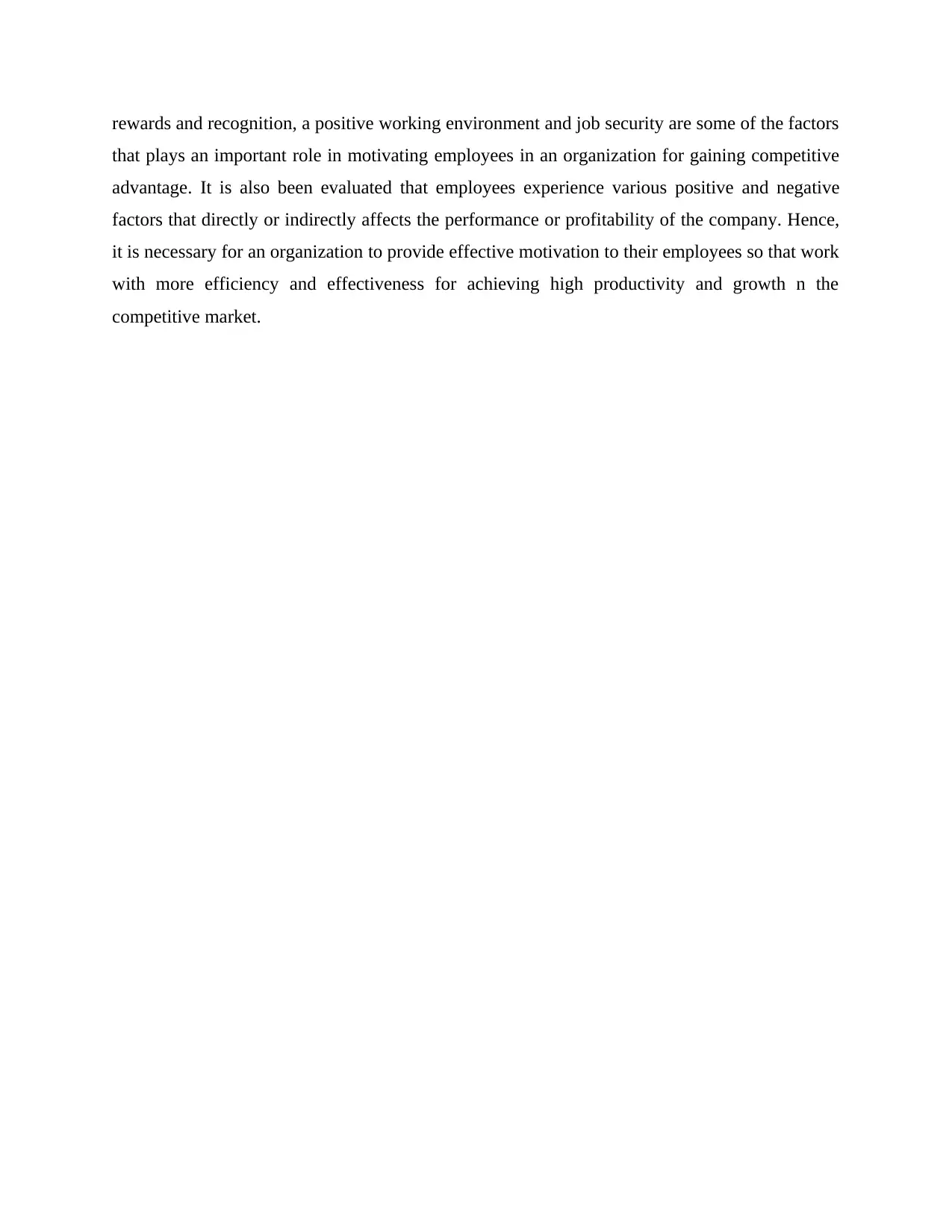
rewards and recognition, a positive working environment and job security are some of the factors
that plays an important role in motivating employees in an organization for gaining competitive
advantage. It is also been evaluated that employees experience various positive and negative
factors that directly or indirectly affects the performance or profitability of the company. Hence,
it is necessary for an organization to provide effective motivation to their employees so that work
with more efficiency and effectiveness for achieving high productivity and growth n the
competitive market.
that plays an important role in motivating employees in an organization for gaining competitive
advantage. It is also been evaluated that employees experience various positive and negative
factors that directly or indirectly affects the performance or profitability of the company. Hence,
it is necessary for an organization to provide effective motivation to their employees so that work
with more efficiency and effectiveness for achieving high productivity and growth n the
competitive market.
Paraphrase This Document
Need a fresh take? Get an instant paraphrase of this document with our AI Paraphraser
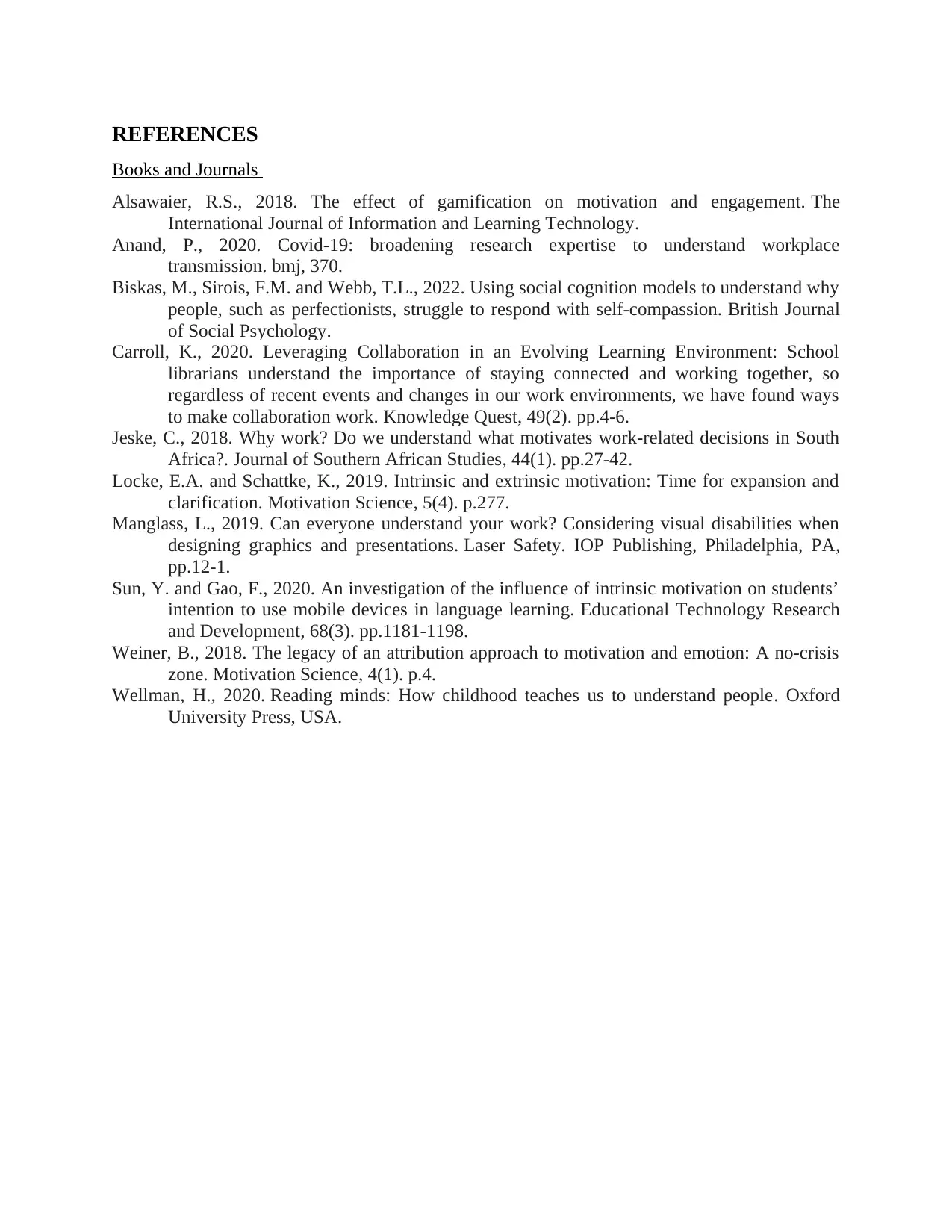
REFERENCES
Books and Journals
Alsawaier, R.S., 2018. The effect of gamification on motivation and engagement. The
International Journal of Information and Learning Technology.
Anand, P., 2020. Covid-19: broadening research expertise to understand workplace
transmission. bmj, 370.
Biskas, M., Sirois, F.M. and Webb, T.L., 2022. Using social cognition models to understand why
people, such as perfectionists, struggle to respond with self‐compassion. British Journal
of Social Psychology.
Carroll, K., 2020. Leveraging Collaboration in an Evolving Learning Environment: School
librarians understand the importance of staying connected and working together, so
regardless of recent events and changes in our work environments, we have found ways
to make collaboration work. Knowledge Quest, 49(2). pp.4-6.
Jeske, C., 2018. Why work? Do we understand what motivates work-related decisions in South
Africa?. Journal of Southern African Studies, 44(1). pp.27-42.
Locke, E.A. and Schattke, K., 2019. Intrinsic and extrinsic motivation: Time for expansion and
clarification. Motivation Science, 5(4). p.277.
Manglass, L., 2019. Can everyone understand your work? Considering visual disabilities when
designing graphics and presentations. Laser Safety. IOP Publishing, Philadelphia, PA,
pp.12-1.
Sun, Y. and Gao, F., 2020. An investigation of the influence of intrinsic motivation on students’
intention to use mobile devices in language learning. Educational Technology Research
and Development, 68(3). pp.1181-1198.
Weiner, B., 2018. The legacy of an attribution approach to motivation and emotion: A no-crisis
zone. Motivation Science, 4(1). p.4.
Wellman, H., 2020. Reading minds: How childhood teaches us to understand people. Oxford
University Press, USA.
Books and Journals
Alsawaier, R.S., 2018. The effect of gamification on motivation and engagement. The
International Journal of Information and Learning Technology.
Anand, P., 2020. Covid-19: broadening research expertise to understand workplace
transmission. bmj, 370.
Biskas, M., Sirois, F.M. and Webb, T.L., 2022. Using social cognition models to understand why
people, such as perfectionists, struggle to respond with self‐compassion. British Journal
of Social Psychology.
Carroll, K., 2020. Leveraging Collaboration in an Evolving Learning Environment: School
librarians understand the importance of staying connected and working together, so
regardless of recent events and changes in our work environments, we have found ways
to make collaboration work. Knowledge Quest, 49(2). pp.4-6.
Jeske, C., 2018. Why work? Do we understand what motivates work-related decisions in South
Africa?. Journal of Southern African Studies, 44(1). pp.27-42.
Locke, E.A. and Schattke, K., 2019. Intrinsic and extrinsic motivation: Time for expansion and
clarification. Motivation Science, 5(4). p.277.
Manglass, L., 2019. Can everyone understand your work? Considering visual disabilities when
designing graphics and presentations. Laser Safety. IOP Publishing, Philadelphia, PA,
pp.12-1.
Sun, Y. and Gao, F., 2020. An investigation of the influence of intrinsic motivation on students’
intention to use mobile devices in language learning. Educational Technology Research
and Development, 68(3). pp.1181-1198.
Weiner, B., 2018. The legacy of an attribution approach to motivation and emotion: A no-crisis
zone. Motivation Science, 4(1). p.4.
Wellman, H., 2020. Reading minds: How childhood teaches us to understand people. Oxford
University Press, USA.
1 out of 8
Related Documents
Your All-in-One AI-Powered Toolkit for Academic Success.
+13062052269
info@desklib.com
Available 24*7 on WhatsApp / Email
![[object Object]](/_next/static/media/star-bottom.7253800d.svg)
Unlock your academic potential
Copyright © 2020–2025 A2Z Services. All Rights Reserved. Developed and managed by ZUCOL.



